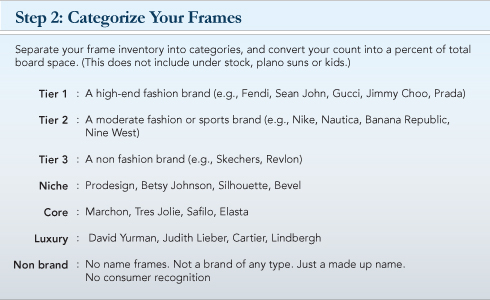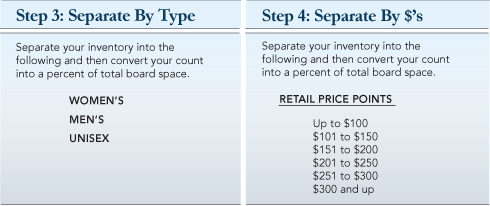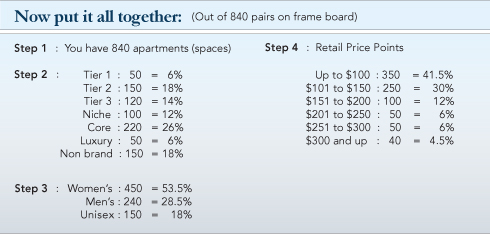By Jay Binkowitz

Buying the right products and creating successful assortments has become more challenging in today’s environment of shifting consumer tastes, increasing price sensitivity and growing shopper diversity.
So what does frame board management really mean? How many of us studied the fine art of retail buying mathematics? Most of us use the “Let’s try it !” method to selecting frames for our optical. We make decisions on products based upon what webelieveconsumers want or quite simply based upon what we personally like. We need to take a more strategic approach with the fundamental objective of maximizing customer satisfaction while minimizing our costs.
Categorize Levels and Price Points

Big box retailers have a slightly more advanced methodology to making their buying decisions. It is not to say that they are right all the time, but successful retailers are rightmost of the time. They understand how to categorize their inventory by levels and price points. Then they use these categories to apply percentages to refine their approach.
The following approach will allow you to identify the holes in your inventory–and enable you to make decisions on purchases that fill aneedand not a want. For instance, when was the last time you were able to say to a rep that you needed to buy a moderate women’s fashion brand that you can sell for $169 and will cost you $45? Or how about a men’s high end brand that you can retail for $350. The art of successful buying has more to it then “the frame looks nice” when we make our decision. There has to be a reason to buy it.




Track Sales and Adjust Percentages
Are your best selling frames core women’s for less than $100? That is what percentages indicate.
Do you want to sell more $151 to $200 frames? Then try increasing this percentage and reducing the number of frames priced below $100
Do you want to sell more $201 to $250? Then you need more products. As consumers, we do not buy from the retailer that has just a few pieces to pick from. Rather we buy from the retailer that has a large robust collection. It creates trust and confidence that the retailer can support the product.
As a buyer you want to massage these numbers to increase your turnover rate and the overall productivity of your inventory dollars. We tend to end up with the 20/80 rule. Twenty percent of our inventory makes up 80 percent of our sales. But that does not have to be if we more carefully track and refine our percentages with the mathematics of board management.
Consistently tracking these numbers and comparing them with your sales will equip you to fine tune your approach. Some categories you may want to decrease when you realize that they do not contribute the sales you would have expected. Visa versa, other categories you may increase when you realize that they are contributing strongly to your sales. Apply this method to measure and fine tune.
Tips For Buyers
Don’t Buy Framesthat Compete with Each Other
This is a common pitfall. If you purchase similar frame lines where one line is less expensive than the other, then you are wasting your time and your money. You are not going to sell the more expensive version. So you need to decide which price point you want to sell and pick one product. And you need to keep an eye to creating an optimal range of assortment. Not just by name but by style.
Strengthen Core Product
How many core product lines do you carry? Pick one company. If you have a showcase that holds 84 units, and you have similar core product from three companies, you have dedicated a lot of your apartments to the same tenant and will not get the rent you need. Reduce your three core companies to one, and carry 42 units instead of 84. You will have more productive tenants that turn over the way you want them to. You will also have a better relationship with your rep.
Pick One Bend and Flex Line
Several companies offer bend and flex materials today. If you carry four or five company’s version of these frames, you are diluting the mix and will have a lower turnover and higher exchange rate for each of the companies. Pick one and be done. You may think you have a large selection of frames, but they really are just all the same to the consumer.
“One in One, Out is the Rule of Thumb.”
You cannot and should not bring in new products without getting rid of the old. You may need to mark down the product. Offering 50 percent off with the purchase of lenses or free frames with the purchase of progressives or you can create very aggressive second pair packages with them. Set up a clearance area, and remove them from your board management allocation. Another good idea: Meet with your rep to find out about exchanging it out for a different line they carry. I always like to give the rep an opportunity to work with me.
Questions When Considering New Product
- How will it impact your practice image?
- Will it help create distinction or create competition with low end discounters?
- Do I have another line that is similar?
- Does it compete for a price point?
Replace Quickly
Whether or not you use a budget philosophy, the bottom line: If you sold it you need to replace it. Good retailers react quickly to popular products. When they sell quickly, they replace quickly to maximize upside and turnover with that brand or style. Successful retailers do not say, “I can’t replace it because I did not budget for it.” All consumer have experienced the frustration of popular products being out of stock. Why give your patients another reason to go elsewhere?
Ask Your Rep What’s Hot
Ask your reps for their top 10 best styles in the two best colors in your area. There is no need to guess which styles to pick.
Give Consumers Selection
Consumers enjoy seeing the true presence of the brands you carry with great merchandising. When they see a BIG selection they realize that there is no need to shop elsewhere. Consumers want value andoptions!
Jay Binkowitz is the President & CEO of GPN, exclusive provider of The EDGE. During the last 30 years he has had extensive experience in retail operations, merchandisingand marketing, manufacturingand distribution, technology development, national sales, and on-site interactive consulting. For more information:click here.





















